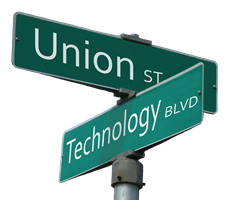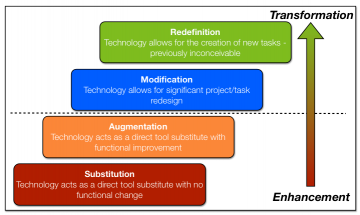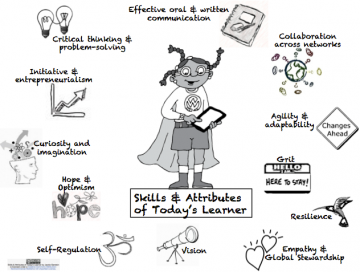
When reading the NMC Horizon Report form 2014, it is amazing to understand how much of what they talked about is becoming reality. What I found the most striking was when they were writing about Digital Strategies and Enabling Technologies, in which something new, easier to use, meaningful and more capable is used to transform what we expect.  When reviewing lessons for the integration of technology, the SAMR model (substitution, augmentation, modification, and redefinition) has been used to outline the progression of a teacher as they continue professional development in teaching and learning. But using digital strategies and enabling technologies, while SAMR can definitely show the development of lessons, but it doesn’t define the professional development that the teacher has had.
When reviewing lessons for the integration of technology, the SAMR model (substitution, augmentation, modification, and redefinition) has been used to outline the progression of a teacher as they continue professional development in teaching and learning. But using digital strategies and enabling technologies, while SAMR can definitely show the development of lessons, but it doesn’t define the professional development that the teacher has had.
The most successful teachers are connected, have an active professional learning network, engage students with the technology, in addition to using technology in or out of the classroom. When teachers have successes integrating technology in or outside of the classroom, they see the benefits which encourage them to take risks and explore other digital strategies, especially those that are promoted by their professional development communities. Which is how I learned about Nearpod. This meets several elements of ISTE Module 3, such as “exhibiting the knowledge and skills, creating the work processes that represent an innovation in a global digital society”. I tried Padlet instead of Coggle, but I will be looking for other options.
Journey to Integration GCP Update/Alignment:
We have had our first interview. Craig Stockton the chair of our IT Advisory Board asked if he could come in person. He brought his laptop with sample code and explained what he was working on. I had asked him to share with the kids how he uses Arrays in his work, and when he came in, he said he really doesn’t use Arrays in his line of work, which is system testing. So we started with questions. Students had prepared their questions on 3X5 cards the day before, they were available for Craig to look through and then I passed them back to the students’ when class started. I also gave them permission to change the question if they had wanted to ask a follow-up question.
Craig asked them to get out paper to take notes and gave them a good description of his work and what is important for them to know. The student did a reflection and handed them in, and I will be putting them together this weekend. I am also waiting for the other speaker to get back to me with a time. I am getting anxious to get him scheduled because I have too few days left before my surgery. GCP Update/Alignment with ISTE Teaching Standard 2: When writing frameworks for my CTE courses, one of the state requirements is that all courses have a leadership element integrated into each unit, but that we also integrated career information.
Usually we integrate an activity where students will research a future career related to the course curriculum, and in my case programming. To help facilitate research of programming our district utilizes a career exploration website, WOIS where students can complete a review of related careers. By allowing the students choice, I am able to “personalize learning activities to address students’ diverse learning styles, working strategies, and abilities using digital tools and resources”. The students find that through the career cluster information they can choose a career that they are interested in.
Communicating with Facebook:
Our school district is working on using social networks, not only do they have a Facebook page, but they have allowed each high school to create their own Facebook page and a Twitter account. An advantage of using social network sites is the speed in which you can share information with students and families. Teachers can easily share multimedia and provide a collaborative learning environment that is familiar with the student and they enjoy. Knowing that students learn more by being actively engaged and motivated by the connection to peers allows for a broader discussion of topics and events. Plus, they enjoy using the technology.
There are also a few drawbacks that must be part of the decision to use Facebook. While this is a good communication tool, it is not the forum for newsletters or forms and official information. Another issue is that not all parents are going to want to add themselves to the school connections, so you will still need to provide information in those other ways. The benefits to parents are as common as finding out what students are doing at school or in class, but also allowing them to choose how they connect with the school. Through multiple choices, they are apt to find a way that interests and works best for them.
Bibliography
Crompton, H. (2014, July 24). Know the ISTE Standards-T 3: Model digital age learning. Retrieved from https://www.iste.org/explore/articleDetail?articleid=109
Dolphy, L. (2015, April 14). Social Network Sites: Facebook For Education? – eLearning Industry. Retrieved May 11, 2016, from http://elearningindustry.com/social-network-sites-Facebook-for-education
Goel, V., & Rich, M. (2015, September 03). Facebook Takes a Step Into Education Software. Retrieved May 11, 2016, from http://www.nytimes.com/2015/09/04/technology/Facebook-education-initiative-aims-to-help-children-learn-at-their-own-pace.html?_r=0
Kabaker, J. (2015). Supporting deeper learning in the classroom. Retrieved from http://www.digitalpromise.org/blog/entry/supporting-deeper-learning-in-the-classroom
New Media Consortium. (2014). NMC Horizon Report: 2014 K-12 Edition (32-45). Retrieved from http://cdn.nmc.org/media/2014-nmc-horizon-report-k12-EN.pdf
Renwick, M. (2015, January 20). Is Facebook the New School Web Page? Retrieved May 12, 2016, from http://www.edtechmagazine.com/k12/article/2015/01/Facebook-new-school-web-page
(Visited 102 times, 1 visits today)

 When reviewing lessons for the integration of technology, the SAMR model (substitution, augmentation, modification, and redefinition) has been used to outline the progression of a teacher as they continue professional development in teaching and learning. But using digital strategies and enabling technologies, while SAMR can definitely show the development of lessons, but it doesn’t define the professional development that the teacher has had.
When reviewing lessons for the integration of technology, the SAMR model (substitution, augmentation, modification, and redefinition) has been used to outline the progression of a teacher as they continue professional development in teaching and learning. But using digital strategies and enabling technologies, while SAMR can definitely show the development of lessons, but it doesn’t define the professional development that the teacher has had.
